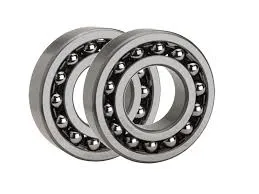
Nov . 09, 2024 10:59 Back to list
Exploring Various Types of Thrust Bearings and Their Applications in Machinery
Different Types of Thrust Bearings
Thrust bearings are essential components in various mechanical systems, designed to handle axial loads – forces acting along the axis of rotation. Unlike other bearings that support radial loads, thrust bearings are specifically engineered to accommodate thrust, making them critical in applications such as automotive, aerospace, and industrial machinery. Understanding the different types of thrust bearings is crucial for selecting the right bearing for specific applications. Here, we explore the main categories of thrust bearings, their designs, and applications.
1. Ball Thrust Bearings
Ball thrust bearings are one of the most common types, consisting of balls placed between two grooved plates. These bearings are capable of handling light to moderate axial loads and are often used in applications like automotive transmissions, machine tool spindles, and general machinery. The primary advantage of ball thrust bearings is their simplicity and ease of assembly. They also provide low friction, which enhances efficiency and reduces wear.
2. Roller Thrust Bearings
Roller thrust bearings employ cylindrical rollers instead of balls, allowing them to support higher loads. These bearings are designed to accommodate heavy axial loads and are used in applications such as marine propulsion systems, large electric motors, and heavy machinery. The increase in contact area between the rollers and the races distributes the load more effectively, making roller thrust bearings ideal for demanding applications. However, their design often requires more precise alignment and can be slightly more complex to install.
Thrust needle bearings consist of a series of needle rollers organized between two plates. They are particularly suited for applications where space is limited, as their low profile design allows for effective load carrying in confined spaces. These bearings are commonly found in automotive gearboxes, appliances, and industrial machinery. They provide excellent performance under high speeds and lighter axial loads, offering a balance between compactness and strength.
different types of thrust bearings

4. Fluid Thrust Bearings
Fluid thrust bearings operate on a different principle, using a thin film of lubricant to support the load. This type of bearing is often used in high-speed applications or environments where conventional bearings might fail. Fluid thrust bearings take advantage of hydrodynamic or hydrostatic lubrication principles, minimizing friction and wear. Common applications include turbines, pumps, and other high-precision rotating equipment. While fluid thrust bearings can be highly effective, they require a reliable lubrication system and are often more complex in design.
5. Magnetic Thrust Bearings
Emerging technologies have paved the way for magnetic thrust bearings, which utilize magnetic fields to support loads without any direct contact between moving parts. This unique design greatly reduces friction, wear, and noise, making magnetic thrust bearings advantageous in applications such as aerospace, high-speed machinery, and sensitive instrumentation. Despite their benefits, magnetic bearings require complex control systems and are typically more expensive than traditional bearings, making their use more specialized.
6. Composite Thrust Bearings
Composite thrust bearings are made from advanced materials that combine the benefits of traditional bearing materials and modern composites. These bearings exhibit excellent wear resistance, reduced weight, and enhanced load-carrying capacity. They are often used in severe environments, such as those exposed to high temperatures or corrosive substances. Applications for composite thrust bearings include aerospace components, automotive engines, and marine propellers.
Conclusion
Selecting the appropriate type of thrust bearing for a specific application is critical for ensuring optimal performance and longevity of machinery. Each type of thrust bearing has unique characteristics that make it suitable for different load capacities, operating environments, and design constraints. By understanding the various types of thrust bearings available, engineers and designers can make informed decisions to enhance the efficiency and reliability of their mechanical systems. Whether it’s the simplicity of ball thrust bearings or the advanced technology of magnetic thrust bearings, the right choice can lead to significant improvements in performance and maintenance.
Latest news
-
Grooved Ball Bearing Design and Functionality
NewsJun.04,2025
-
Concrete Mixer Bearing Load Capacity Testing
NewsJun.04,2025
-
6004 Bearing Dimensions in Robotic Joint Designs
NewsJun.04,2025
-
Advantages of Single-Row Deep Groove Ball Bearings
NewsJun.04,2025
-
Applications of Deep Groove Ball Bearings in Automotive Systems
NewsJun.04,2025
-
Innovations in Bearing Pressing Machine Design
NewsJun.04,2025
